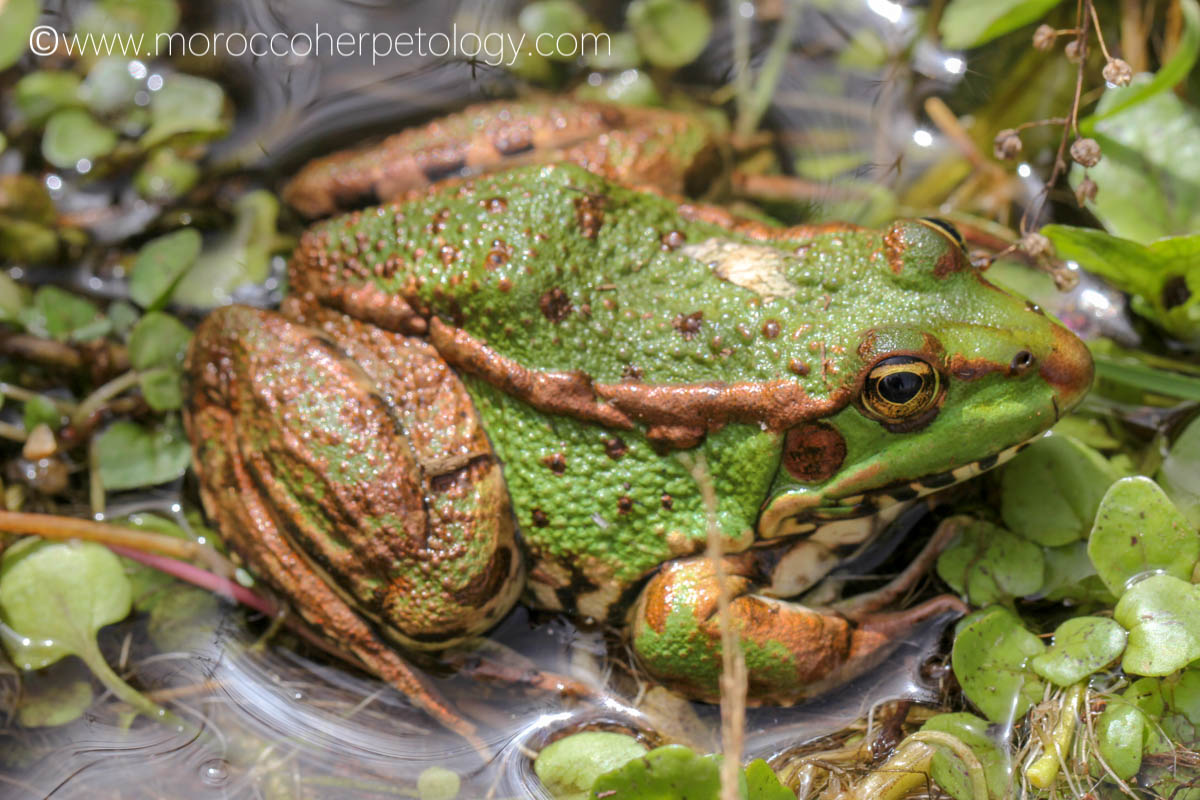Morocco boasts a rich diversity of amphibians, with a more than 27 % endemism rate among Mediterranean countries (Reques et al., 2013 ; Bouazza et al., 2021). The country is home to 14 amphibian species, including the endangered Pelobates varaldii and vulnerable species like Salamandra algira ssp. and Sclerophrys xeros.
Amphibian species richness is highest in northern Morocco, where diverse habitats thrive due to higher rainfall and varied habitats. In contrast, the Sahara desert is largely devoid of amphibians. Despite their ecological importance, many critical habitats remain unprotected (e.g. Days and Gueltats).
Commonly known as salamanders, are a group of amphibians characterized by their elongated bodies, tails, and moist skin. They typically inhabit moist environments, including forests, wetlands, and streams. In Morocco, the most notable species within this group is Salamandra algira, which is endemic to the Maghreb. Salamanders play a crucial role in their ecosystems as both predators and prey, and they are sensitive to environmental changes, making them important indicators of ecosystem health. Their populations are threatened by habitat destruction, pollution, and climate change, necessitating conservation efforts to protect their habitats and ensure their survival
This family includes two notable species found in Morocco, characterized by their smooth, moist skin and a life cycle that typically involves both aquatic and terrestrial phases.
Salamandra algira is recognized by its vibrant coloration, often featuring striking yellow or orange spots on a dark background. It comprises five subspecies (see more in AmphibiaWeb ) :
- S. a. tingitana occupies the northwestern Rif, ranging from Ceuta to Chefchouen;
- S. a. splendens extends into the south-central Rif, from Chefchouen to Al Hocéima southwards;
- S. a. atlantica is found in the northern and central parts of the Middle Atlas;
- S. a. spelaea is restricted to a small range in the Beni Snassen massif, near the Morocco-Algeria border; and the nominal
- S. a. algira is restricted to Algeria, in the coastal mountainous regions of Annaba, Kabylia, Blida Atlas and Oranie.
Pleurodeles waltl: Primarily found in Europe and North Africa, Pleurodeles waltl is a notable species known for its adaptability to various habitats, including both natural and anthropogenic environments.
Commonly referred to as frogs and toads, is the largest order of amphibians, known for their jumping abilities, vocalizations, and diverse habitats. In Morocco, this group includes 12 species. Anurans are found in a variety of environments, from wetlands to deserts, and they play essential roles in food webs as both predators and prey. Many species are facing threats from habitat loss and climate change, which have led to declines in their populations.
The genera Alytes and Discoglossus are both significant in the context of Moroccan amphibians. The notable species Alytes maurus, known as the Moroccan midwife toad, is distinguished by its unique reproductive behavior, in which males carry fertilized eggs wrapped around their hind legs until they hatch. This species typically inhabits humid montane and forested regions, often near water sources, and has a fragmented distribution primarily in the Rif Mountains and Jbel Tazekka.
On the other hand, Discoglossus scovazzi & Discoglossus pictus, commonly referred to as painted frogs, are adaptable and can be found in a variety of habitats, including temporary and ephemeral ponds, montane streams, and even semiarid zones.
Pelobatidae, or spadefoot toads, are amphibians known for their burrowing adaptations and spade-like structures on their hind feet. Found in Europe, North Africa, and parts of Asia, they inhabit sandy or loose soils and are primarily nocturnal. Notable species include Pelobates varaldii, the Moroccan spadefoot toad, which breeds in temporary ponds, especially in Maamoura forest.
Bufonidae, commonly known as true toads, are a family of amphibians recognized for their stout bodies, dry, warty skin, and short legs. These toads are found worldwide, except in extreme polar regions. Primarily terrestrial, Bufonidae species inhabit diverse environments, including forests, grasslands, and deserts.
Notable species in Morocco include:
- Barbarophryne brongersmai (Brongersm's Toad): Endemic to Morocco, this species faces potential threats from habitat destruction and climate change due to its limited distribution and specific habitat requirements.
- Bufo boulengeri (Boulenger's Toad): Widespread throughout Morocco.
- Sclerophrys mauritanica(Berber Toad): A Maghrebian endemic species.
- Sclerophrys xeros (Savannah Toad) :This species is typically found in the extreme southern regions of Morocco (Adrar Souttouf). It is adapted to survive in dry conditions and relies on seasonal water bodies for breeding.
- Bufo spinosus (Spiny Toad): Found in Morocco, with relictual populations.
Hylidae, commonly known as tree frogs, is a family of frogs primarily characterized by their arboreal (tree-dwelling) habits, though some species also inhabit terrestrial or aquatic environments. Members of this family are distinguished by their long limbs, adhesive toe pads, and distinctive vocalizations, often used during mating calls.
Notable species in Morocco is Hyla meridionalis (Mediterranean Tree Frog): Widely distributed throughout Morocco, this adaptable species is found in various environments, including coastal wetlands and montane habitats. It is commonly seen near still or moving water and is known for thriving in diverse habitats.
In Morocco, the family Ranidae includes species such as Pelophylax saharicus (Saharan green frog), which is widely distributed from sea level to mountainous regions (2650 m.a.sl). These frogs inhabit various aquatic environments, including irrigation ditches (Saguia), ponds, and temporary pools (Daya). They are generally abundant where wetland habitats exist, although their populations can be fragmented in desert areas due to habitat availability.
The groove- crowned bullfrog, widely distributed further south in Africa, recently has been found in Atlantic Sahara (Reques et al., 2013). Known only from the south- western margin of Moroccan Sahara (Molomhar, Adrar, Mauritania) it survives in temporary ponds of fresh water in regions with a Sahelian climate















